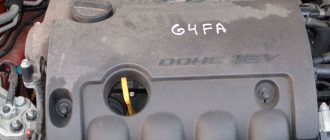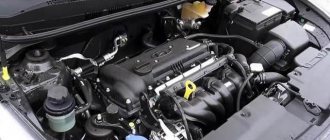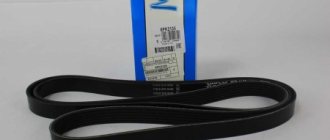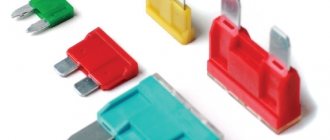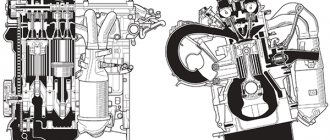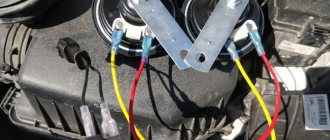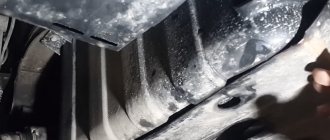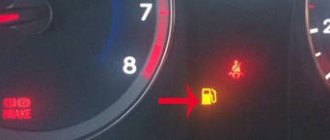- home
- Engine
- …
Very often I have to read questions - “tell us about the Hyundai Solaris and KIA RIO engines, whether they are reliable or not, how long they last (resource), what problems there are, pros and cons, etc.” After all, these Korean cars are among the best-selling and there is a lot of interest in them. I haven’t recorded this video for a long time (I thought everything had already been said before me in hundreds of videos and articles), but readers want my opinion, so I decided to write it today. As usual there will be a video version at the end...
It is worth noting that these power units are also found in most other Korean cars of a higher class, such as KIA CEED and CERATO, as well as Hyundai Elantra, I30 and CRETA. They are also common in Russia, and therefore the information will be of interest to their owners.
For the impatient, I would like to say one thing - THESE ENGINES ARE RELIABLE AS A HAMMER, THERE ARE SIMPLY NO COMMON PROBLEMS WITH THEM NOW. Feel free to take it.
But for those who want to learn more about the engines of these Korean units, read on.
What motors are installed?
Let's start with old cars (2010 - 2021), they were equipped with only two power units, the GAMMA generation 1.4 liters (107 hp) and 1.6 liters (123 hp)
At the moment (since 2021), both Solaris and RIO are equipped with two engine options - the so-called KAPPA (volume 1.4 liters - 100 hp) and GAMMAII (1.6 liters - 123 hp .) .
The KAPPA generation began to be installed on “poor” versions of the new generation of cars only in 2021; in high trim levels there is a modified GAMMAII engine (unspoken name)
Vin code Kia Ceed JD (2nd generation, 2012-2018)
Since the Kaliningrad Avtotor produces large-unit assembly of the Kia Sid 2, copies of this model assembled in Russia have two VINs (Russian and Slovak).
The combination indicating Russian assembly is applied to the right front side member in the form of dots using a laser. The marking is approximately located in the place where the drive belt of the Kia Sid 2 power plant is located.
A plate with duplicate information can be found by examining the bottom of the front right pillar . The characters are printed using a micro-mill, so the data is not difficult to fake.
The Slovak combination is located in the car interior . The front passenger seat must be moved all the way back. Please note that traces of depressurization of the bolts securing the seat may indicate a fake ID. When applying this VIN code to the Kia Sid, the same technology was used, but the combination was covered with paint. To make sure that the combination is not interrupted by scammers, get rid of the threshold trim secured with clips. Inspect the factory spot weld on the strip fastening - it should be intact, without signs of re-painting.
The VIN plate can be found on the surface of the B-pillar on the left side of the Kia Ceed 2021 body. The same data is printed under the windshield .
Before purchasing, be sure to check the Korean combination with the code programmed in the electronic control unit.
You can find this information in the ECU by conducting computer diagnostics of the Kia Sid.
Decoding
Despite the double marking of the Kia Sid JD cars assembled in Russia, the VIN from AVTOTOR is entered into the registration documents.
This code starts with the combination XWE . The special marks on the certificate indicate the Slovak VIN number starting with the characters U5Y. All characters of these identifiers encrypt data about the machine.
Let's decipher the information from the Slovak combination using the example code U5YHN812BDL032129 :
- U5Y marking indicates that the components for this Kia Sid were manufactured in Slovakia;
- H symbol is a model identifier;
- The Latin letter N refers to the model and serial number;
- The number 8 indicates the station wagon body type;
- Number 1 contains information about the type of restraint system - active seat belt;
- Number 2 indicates the type of power plant 1.6 DOHC;
- Symbol B indicates a single-wheel drive left-hand drive car equipped with an automatic transmission;
- D identifies the year of manufacture and corresponds to 2013;
- The symbol L is the code for the assembly capacity of the Žilina plant;
- The last 6 digits (032129) are the serial production number of the Kia Sid.
How to decipher the data of the Russian VIN code printed on the Kia Sid 2 using the example number XWEHN812BD0002543 :
- XWE combination indicates assembly at the Russian Avtotor facilities;
- HN812BD symbols correspond to the information that is indicated in a similar combination of the Slovak VIN of a Kia Sid;
- Digit 0 is the code of the Kaliningrad Automobile Plant;
- The last 6 digits (in the example - 002543) correspond to the serial production number.
GAMMA engine (G4FA and G4FC)
Perhaps I’ll start with a description of these engines, as well as with the structural features (the analysis will be very detailed, so stock up on tea):
Where they produce: The plant is located in China (Beijing Hyundai Motor Co). There is often a very biased attitude towards this country, that “they say” everything is of poor quality and so on. However, do not confuse underground and factory production (this is a huge difference). And so for a moment IPHONE is also made in the Middle Kingdom.
Fuel supply system, recommended gasoline and compression ratio : Injector, multipoint injection (MPI). I think this is a plus, because this system is very simple, the injectors do not have contact with the combustion chambers (like GDI direct injection), here they are built into the intake manifold. They are cheaper, the pressure is lower (there is no analogue to the injection pump), and you can clean them yourself. In general, I advise you to read the article MPI or GDI , everything in it is simple and straightforward. Gasoline can be filled no lower than 92 , it works great on it (this is another plus). Compression ratio – 10.5.
Engine block : I won’t spend a lot of time on it now - YES IT’S ALUMINUM with thin-walled dry cast iron liners (they are poured in at the time of production). How many people “shout” (on various forums) that the power unit is disposable and that “they say” it’s driven for 180,000 km and throws it all away ( about the resource a little later). However, as practice shows, these motors can be easily repaired. There are a bunch of videos on the Internet where these old worn-out liners are thrown out and new ones are put in their place (and then the piston liner, etc.). So Russian masters can do a lot - THIS IS A FACT!
Cylinders, pistons, crankshaft: 4 pieces in a row, lightweight oil scraper pistons and compression rings of normal sizes (although they could have been thicker). The crankshaft and its bearings do not cause any complaints, they run for a very long time (this unit is not a problematic link)
Timing system : ON the SOLARIS - RIO engine, two camshafts are installed, 4 valves per cylinder (that is, 16 valves). hydraulic compensators , only pushers are installed. There is a timing chain mechanism with a hydraulic chain tensioner. There is one phase shifter , located on the intake shaft.
Intake and exhaust manifold : Intake – plastic, with variable intake geometry system (VIS). Graduation – stainless steel. In fact, everything is very simple.
Oil: Replacement is allowed every 15,000 km, synthetic 5W30, 5W40 is recommended. Volume approximately 3.3 liters. Operating temperature – 90 degrees Celsius
Resource declared by the manufacturer : about 200,000 km.
Difference between 1.4 and 1.6 liter engines : The weak version is abbreviated G4 FA (1.4L-107) , the older version is known as G4 FC (1.6L-123) . The engines are almost identical, the only difference is that the more powerful version has a piston stroke of 85.4 mm, and the weaker version has a piston stroke of 75 mm (different crankshaft). Thus, “1.6” simply sucks in a larger volume of fuel - EVERYTHING ELSE IS WITHOUT CHANGES (it will be very detailed in the video version).
Characteristics
| Production | Beijing Hyundai Motor Co. |
| Engine make | G4FC |
| Years of manufacture | 2006-2017 |
| Cylinder block material | aluminum |
| Supply system | injector |
| Type | in-line |
| Number of cylinders | 4 |
| Valves per cylinder | 4 |
| Piston stroke, mm | 85.4 |
| Cylinder diameter, mm | 77 |
| Compression ratio | 10.5 |
| Engine capacity, cc | 1591 |
| Engine power, hp/rpm | 123/6000 123/6300 126/6300 |
| Torque, Nm/rpm | 156/4200 155/4200 157/4200 |
| Fuel | 92+ |
| Environmental standards | Euro 4 Euro 5 |
| Engine weight, kg | 99.8 (dry) |
| Fuel consumption, l/100 km (for Kia Rio) - city - highway - mixed. | 8.55.2 6.4 |
| Oil consumption, g/1000 km | up to 600 |
| Engine oil | 0W-30 0W-40 5W-30 5W-40 |
| How much oil is in the engine, l | 3.6 |
| Oil change carried out, km | 15000 (better 7500) |
| Engine operating temperature, degrees. | ~90 |
| Engine life, thousand km - according to the plant - in practice | 180+ 300+ |
| Tuning, hp — potential — without loss of resource | 140 140 |
| The engine was installed | Hyundai i30 Hyundai Elantra Hyundai Solaris KIA Ceed KIA Cerato KIA Rio KIA Soul Hyundai i20 KIA Venga |
Difference between GAMMA and GAMMAII (G4FG)
As I wrote above, the generation of GAMMA engines was installed not only on HYUNDAI SOLARIS and KIA RIO, but also on CEED, CERATO, ELANTRA, I30 and, say, CRETA. But if on SOLARIS (RIO) the power was 123 hp, then let’s say on various SIDs, ELANTRAs and other C-classes it was 128-130 hp. Why is that?
IT'S SIMPLE:
Behind the scenes there is such a difference as GAMMA and GAMMAII motors:
GAMMA are power units with one intake phase shifter, volumes of 1.4 liters (coded G4FA ) and 1.6 liters ( G4FC ).
GAMMAII - until 2021, installed only on CEED, i30, CERATO, ELANTRA, etc. (power varied from 128 to 130 hp). Since 2021, they are also installed on SOLARIS, RIO and CRETA (power is artificially reduced to 123 hp). The only difference is that they have two phase shifters on both shafts, the volume is 1.6 liters (coded G4FG ). Otherwise the design is identical
The bottom line is that from 2021, the engines on SOLARIS and RIO have become different (as on ELANTRA, SID and others), both 1.4 and 1.6 liters. It may not be critical, but they are different.
Pros, cons and resource
I'll start with the resource - this will be the first advantage . The manufacturer gives about 200,000 km, but now there are cars since 2010 that have already covered 500 - 600,000 km and you know, the engines work, no matter what (no matter how much they are scolded).
Indeed, the units are problem-free , and they often do not run on the best 92 gasoline. It is worth noting the convenient location, everything can be reached and easily replaced (spark plugs, air filter), intake and exhaust manifolds, engine mounts. Short inlet, and this is not unimportant (the shorter it is, the less pumping losses due to suction). Also, there is not such a large volume of plastic as now in many modern engines. The main thing is to maintain it on time (I still recommend you change the oil every 10,000 km), use high-quality synthetics (there is still a phase shifter and a chain tensioner), and fill in 95 gasoline.
On the downsides (although these are not downsides, but my recommendations). The noisy operation of the fuel injectors is not fatal, but it is a fact (it does not seem to be a chattering chain). There are no hydraulic compensators (there are ordinary pushers) they need to be changed (by selecting new ones according to height) approximately once every 100,000 km. It is also advisable to replace the chain mechanism, and the timing chain itself, up to 150,000 km. Sometimes there are problems with the catalyst (it can simply crumble), crumbs from it get into the cylinders and can very quickly kill the engine. The problem is not widespread, but it happens, as dealers assure, from low-quality fuel, so refuel at normal gas stations
If we sum up the G4FA or G4FC, G4FG motor, then they really now have a great resource. As one mechanic told me, “reliable as a hammer and that not all Japanese walk like that now.” THIS IS WHY many taxi companies love them so much.
Engine KAPPA 1.4 MPI (G4LC)
In my opinion, this is a continuation of GAMMA motors, but KAPPA also has its own tricks. Codename G4 LC . Before installation on Solaris and RIO, this engine was installed on HYUNDAI i30 and KIA CEED.
Power : The very first thing worth noting is its horsepower – 99.7 hp. (in the nomenclature it is written that 100 hp). This was done specifically for tax purposes, because in early versions of the CEED and i30 such engines developed approximately 109 hp. So after the purchase you can restore justice with factory firmware ( chip tuning ) from Korea
Where it is collected : According to the latest information, they are supplied directly from Korea (there is no talk about China).
Fuel supply system, gasoline, compression ratio: Here, multiport fuel injection (MPI) injectors are installed in a plastic intake manifold. Gasoline no less than 92. Compression ratio 10.5
Engine block: Aluminum with dry cast iron liners. Essentially the design is similar to GAMMA, but the KAPPA block is lighter by 14 kilograms compared to its predecessor! This causes concern, the motors are already “thin”, and here 14 kg have been removed from somewhere.
Cylinders, pistons, crankshaft: 4 – cylinder, arranged in a row. The pistons are even more lightweight than their predecessor. HOWEVER, as the manufacturer assures, there are piston cooling nozzles - THIS IS REALLY A PLUS. The connecting rods are thinner, but they are longer. The crankshaft is similar to G4FA and G4FC, but according to my data the journals are slightly narrower. Again, relief in everything is not very good.
Timing system: 16 valves (4 per cylinder). Again, there are no hydraulic compensators, there are ordinary pushers. BUT there are two phase shifters on the intake and exhaust shafts (D-CVVT). There is a plate toothed chain.
Intake and exhaust manifold : As usual, the intake manifold is made of plastic, with a variable intake geometry system (VIS). The outlet is made of stainless steel, with a catalyst built into it.
Lubrication: You need to fill it with synthetic 5W30 or 5W40, replacement is allowed after 15,000 km (volume is also about 3.3 liters). Operates at a temperature of -90 degrees Celsius.
The manufacturer's resource is about 200,000 km.
Interpretation of the marking plate
The nameplate duplicates the information encrypted in the VIN number and also contains some technical characteristics of the car.
This element is located at the bottom of the driver's door frame .
In the upper left corner there is a transmission type marking (1) . The block to the right contains a code with the gearbox type (2) . The third inscription in the top row is the Kia Sid paint code (3) . The following inscription encrypts the color code of the interior elements (4) . The right block on the plate begins with data about the Kia Ceed manufacturer (5) . The second line of the block corresponds to the manufacturing license number (6) . The third line is the VIN combination (7) . Points 8 and 9 mean the permissible gross weight of the car and the permissible gross weight when towing a trailer, respectively. The last two points (10 and 11) inform about the permissible loads on the Kia Sid axles - front and rear, respectively.
Pros and cons of KAPPA
If we compare the G4LC and G4FA (1.4 liters), then in the KAPPA generation maximum power is achieved already at 6000 rpm. Whereas GAMMA at 6300 rpm. We achieved this with a longer piston stroke:
GAMMA1.4 , stroke-75mm, diameter-77mm
KAPPA1.4 , stroke 84mm, diameter 72mm. That is, he is smaller, but he walks more.
Another plus is good fuel economy (up to 0.2-0.3 liters per 100 km, if compared with the opponent) and the elasticity of the engine; it also has two phase shifters. Well, reducing weight by 14 kg also gives advantages in acceleration and fuel consumption.
Here, in most cases, there are also metal throttles and thermostats, and there is cooling of the cylinders with injectors. With proper maintenance (change the oil every 10,000 km and pour good oil), they last more than 250,000 km (this has been proven by the operation of the i30 and CEED). By the way, they are now installing it on RIO X-Line
The disadvantages are the LIGHTENING of everything and everyone, especially the block, connecting rods, pistons (by 14 kg). Of course, “ motor capital ” is also possible (by folk craftsmen), but it will be more accurate and complex. Again, the injectors are noisy, this is just a design specificity. We change the pushers every 100,000 km and the chain mechanism every 150,000 km (although this is not that expensive by modern standards). Just like on many modern cars, there may be problems with scuffing from the catalyst (but this is not a complaint about this power unit).
The engine also turned out to be successful, and picks up much faster than the opponent, runs easily up to 250,000 km and has virtually no problems with proper care.
Now we are watching the video version of the article, I think it will be interesting.
To sum it up, we can say that any 1.4 or 1.6 liter engine in HYUNDAI Solaris, Elantra, i30, Creta, as well as in KIA RIO, RIO X-line, CEED, Cerato RUN WITHOUT PROBLEMS, often just huge runs of 500 - 600,000 km. TAKE IT, DON'T BE AFRAID.
That's all for me, YOUR SINCERELY AUTOBLOGGER.
Similar news
- 8 or 16 valves, which is better? And what exactly is the difference? More details...
- Spark plug heat rating - what is it? Details + video
- Engine oil darkens: main reasons, good or bad?
Add a comment Cancel reply
All about the second generation of KIA RIO engines
KIA RIO, which is in significant demand, is a relatively small B class car. The development of KIA RIO was carried out on the basis of Hyundai Solaris. The car was created in order to compete for the buyer's choice in the most affordable segment. In particular, opponents of RIA RIO are such representatives of the affordable segment as Lada Granta/Kalina 2, VW Polo Sedan, Ford Fiesta, Skoda Fabia/Rapid, Lada Vesta. At the same time, KIA RIO was created as the younger brother of the Kia Cerato/Ceed. The third generation of KIA RIO is in great demand among consumers due to its external design, high operational reliability and powerful engine. Let's pay attention to the latter. Thanks to our website, the reader will learn about the advantages and disadvantages of this engine, which oil is best to use in order to extend the life of the KIA RIO engine and how to do it. We will tell you about the main characteristics of the KIA RIO engine, features of repair and operation.
ENGINE G4FA 1.4 L. (2011 - N.V.)
The G4FA engine is new to the Gamma series, which was released in 2007, replacing the outdated Alpha models. The Gamma series is represented by two engines, G4FA with a volume of 1.4 liters and 1.6 liter G4FC, both equipped with the same cylinder block. The G4FA engine, unlike the older representatives of the Alpha series, uses a timing chain with tensioners that does not require maintenance during the service life specified by the manufacturer. The Solaris/RIO 1.4 engine has a variable valve timing system, exclusively on the intake shaft; the G4FA engine also does not have hydraulic compensators, and therefore, once every 95,000 kilometers, it is necessary to adjust the valve clearances by replacing pushers, which requires additional costs. However, this requirement should not be ignored, otherwise it may result in significant problems such as noise, tripping, burnouts and other malfunctions. For those curious, let us clarify that the manufacturer of the Hyundai Solaris/KIA RIO engine is Beijing Hyundai Motor Company. Being a representative of the Chinese engine industry, the G4FA engine has its own advantages. Let's try to evaluate the pros and cons, and then draw conclusions.
- The first thing that worries the driver is a knocking sound in the KIA RIO or Hyundai Solaris engine. The disappearance of the knocking noise after the car warms up most likely indicates that the cause of the noise is the timing chain (this is true for 90% of cases). Accordingly, there is no reason to worry. When the tapping does not disappear after warming up, you should pay attention to the valves; perhaps they are not adjusted and this needs to be corrected.
- Noises such as clicking, clattering, chirping and the like should not cause concern. Such sounds accompany the work done by the injectors.
- Oil leaks are rare. However, the valve cover gasket cannot be called perfect. Oil stains indicate that the gasket needs to be replaced.
- Instability of revolutions and inconsistent operation of the Hyundai Solaris/KIA RIO engine are a common problem; most often this can be easily eliminated after cleaning the throttle valve. If the problem persists, fresh firmware is needed.
- If there is vibration at idle, the problem may be a dirty throttle valve or spark plugs; cleaning the throttle valve and replacing spark plugs solves the problem. In case of significant vibrations, attention must be paid to the engine mounts.
- A similar symptom occurs at medium speeds (about 3000 rpm). It is difficult to determine the cause in this case. Official representatives of Hyundai-Kia attribute everything to engine features; medium speeds cause the G4FA engine to resonate. In this case, the design features responsible for mounting the engine direct vibration to the steering wheel and body. Gasping or reducing the speed will allow the engine to come out of resonance, and the vibration will disappear.
- The whistle is caused by weak tension in the alternator belt; replacing the tensioner pulley corrects the situation. These are the most common problems with Hyundai Solaris/KIA RIO/Ceed 1.4 engines, however, despite their insignificance, the problem is that in relation to the engine in question, these symptoms appear almost immediately. In addition, the G4FA engine is called disposable and cannot be repaired. The absence of a boring for the repair size leads to the need to replace the entire cylinder block. The resource is modest and amounts to only 180 thousand km, which is lower than the VAZ representatives. Naturally, with moderate use, timely maintenance and oil changes twice as frequent as specified by the manufacturer, it is possible to cover over 200 thousand km, but only a few will be able to comply with these requirements. Therefore, you should be extremely careful when purchasing a used car with such an engine. By purchasing such a car, which has a mileage of over 100 thousand km, you can become the owner of a dummy. In addition to the Hyundai Solaris and KIA RIO, the engines in question are installed on the Kia Ceed II/i20, only the installed version is slightly derated, about 100 hp. The G4FA engine served as the basis for the development of the 1.6 liter Gamma G4FC series engine. In this regard, the engine number mark is placed similarly on both engines, the place where the mark is knocked out is the cylinder block in the area where the gearbox and flywheel meet.
TUNING OPPORTUNITIES
The most acceptable way to increase power is to calibrate the engine. Experts recommend a chip of 110-115 hp, but in practice, the changes are minor. With an increase in income, the use of a 4-2-1 spider or custom-made, with a 51 mm exhaust pipe, porting of the cylinder head with enlarged valves, firmware, tuning horses 120-125 can help. Ideally, it is necessary to add wide shafts to all of the above, but sports-type camshafts for Hyundai Solaris/ KIA RIO are almost impossible to detect.
COMPRESSOR INSTALLATION AND TURBO CHECKING
Installing a compressor on a classic piston engine will eventually cause the engine to fall apart; it must be decompressed. There are a couple of ways: install a couple of cylinder head gaskets or a fresh forged piston at a compression ratio of about 8.5. Forging is not cheap, but it easily maintains a pressure of 0.7 bar from the RK-23 and a relative turbine. Two cylinder head gaskets are economical, but the maximum is RK-23-1 with a pressure of 0.5-0.6 bar. In addition to the compressor, it is necessary to install a 51 mm exhaust pipe. About 140 hp will be able to achieve. If you further improve the cylinder head, by grinding out the intake and exhaust channels and installing large valves, you can achieve a power of 150-160 hp. To turbocharge a car, it is necessary to make a turbo manifold for the TD04L, Garrett GT15 or 17 turbine, oil supply to the turbine, intercooler, piping, 440cc injectors, exhaust on a 51 (63) mm pipe, custom shafts with a phase of about 270 and significant lift, consumables. The listed elements must be installed and configured. Proper tuning of the Hyundai Solaris/KIA RIO turbine allows you to achieve 180 hp.
ENGINE G4FC 1.6 L. (2011 - N.V.)
The G4FC engine is a representative of the Gamma series and its difference from the G4FA is in the crankshaft, which has a piston stroke increased from 75 mm to 85.4 mm. Except for this, both engines are identical, both have a system for changing valve timing on the same shaft, a timing chain. The similarity is further enhanced by the same shortcomings. This is the presence of noise, whistles, vibrations, and unstable speed. Methods for eliminating these symptoms are similar to the G4FA engine. Accordingly, if the question arises of choosing a Hyundai Solaris/KIA RIO engine between 1.4 liters. or 1.6 l., it’s better to choose the latter. The engine is more powerful, but the disadvantages are the same. There is also a version of the Gamma II engine that has a variable valve timing system on two camshafts, this adds power, reaching 128-130 hp. Abroad there are advanced versions of G4FC, owners of direct injection GDI (G4FD) and T-GDI (G4FJ) with turbocharging.
TUNING, COMPRESSOR INSTALLATION AND TURBO CHARGING
As in the case of the G4FA engine, calibrating the G4FC engine will be the simplest and most affordable tuning option; this method will allow you to achieve 130-135-140 hp without requiring significant costs. To go further, an option with a typical pelvis and 4-2-1 spider, with a 51 mm exhaust pipe is required. The chip exhaust option will add even more advantages, and porting the cylinder head and installing large valves will allow you to achieve 150 hp. If finances allow, you can order sports shafts with greater lift and a wider phase, a receiver for the camshaft, all this will allow you to achieve even more power. If we talk about the compressor, the options for the G4FA are also valid for the G4FC engine.
| Engine | Kia-Hyundai G4FA | Kia-Hyundai G4FC |
| Manufacturer | Beijing Hyundai Motor Co | Beijing Hyundai Motor Co |
| Engine make | G4FA | G4FC |
| Year of issue | 2011 - present | 2011 - present |
| Cylinder block material | aluminum | aluminum |
| Supply system | injector | injector |
| Type | in-line | in-line |
| Number of cylinders | 4 | 4 |
| Number of valves per cylinder | 4 | 4 |
| Piston stroke | 75 mm | 85.4 mm. |
| Cylinder diameter | 77 mm | 77 |
| Compression ratio | 10.5 | 11 |
| Engine capacity | 1394 cm cube | 1591 cm cube |
| Engine power | 107-109 hp/6300 rpm | 122-130 hp/6000 rpm |
| Torque | 135 Nm/5000 rpm | 155 Nm/4200 rpm |
| Fuel | 92 | 92 |
| Environmental standards | Euro 4 | Euro 4 |
| Engine weight | n.d. | n.d. |
| Fuel consumption | ||
| - city | 7.8 l. per 100 km. | 7.9 l. per 100 km. |
| - track | 5.0 l. per 100 km. | 4.9 l. per 100 km. |
| - mixed | 6.0 l. per 100 km. | 6.0 l. per 100 km. |
| Oil consumption | up to 1 l. per 1000 km. (in difficult conditions) | up to 1l. per 1000 km. (in difficult conditions) |
| Engine oil | 0W-30/0W-40/5W-30/5W-40 | 0W-30/0W-40/5W-30/5W-40 |
| Engine oil volume | 3.3 l. | 3.3 l. |
| Oil volume for replacement | about 3 l. | 3 l. |
| Oil change frequency | once every 15,000 km. (better 7500 km.) | once every 15,000 km. (better 75,000 km.) |
| Engine operating temperature | about 90 degrees. | about 90 degrees. |
| Engine life | ||
| - according to the manufacturer | 180 thousand km. | 180 thousand km |
| - according to user data | more than 200 thousand km | more than 200 thousand km |
| Tuning | ||
| — potential | more than 200 hp | more than 200 hp |
| - without loss of resource | 110-115 hp | 130-135 hp |
| The engine was installed | Hyundai Solaris/Kia Rio/Kia Ceed/Hyundai i20/Hyundai i30 | Hyundai Solaris/Kia Rio/Kia Ceed/Kia Cerato/Hyundai Elantra/Hyundai i20/Hyundai i30 |

